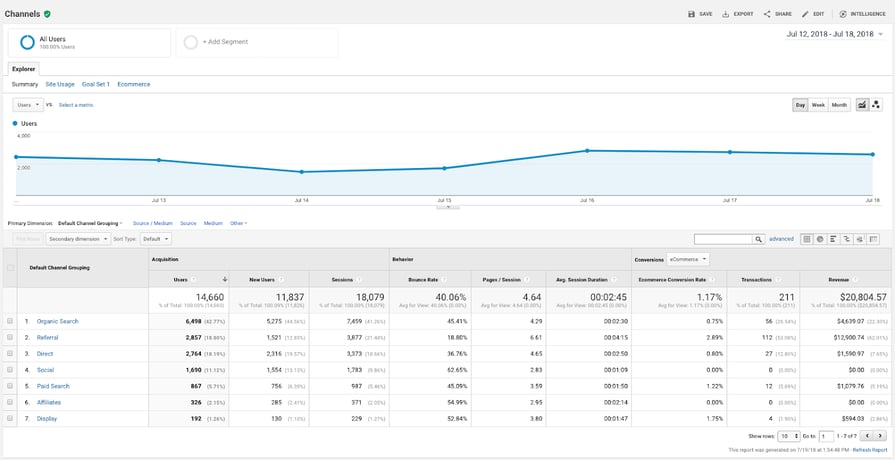A Full Overview to Understanding When Does the Google Analytics Tracking Code Send an Event Hit to Analytics
Master Web Site Insights With Accurate Google Analytics Monitoring Code
The reliable use of Google Analytics hinges on the specific implementation of its tracking code, a fundamental action usually neglected by internet site proprietors. What are the typical mistakes that could undermine your monitoring efforts, and exactly how can you ensure precision in your technique?
Comprehending Google Analytics Essentials
Google Analytics is a crucial device for site proprietors and marketing professionals, providing indispensable insights right into customer behavior and website efficiency. At its core, Google Analytics collects data concerning visitors to an internet site, allowing customers to examine metrics such as website traffic sources, individual interaction, and conversion prices. Comprehending these basics is important for optimizing a web site's performance and enhancing customer experience.
The platform utilizes cookies to track interactions, taping information such as web page sights, session durations, and bounce prices. This details is accumulated and provided via adjustable control panels, making it possible for users to imagine patterns gradually. Secret efficiency indications (KPIs) can be kept track of, such as the overall variety of users, new versus returning visitors, and the geographic distribution of the target market.
Moreover, Google Analytics uses division features, allowing customers to separate particular web traffic sources or user demographics for even more targeted evaluation. By mastering these foundational aspects, site owners can make informed choices about web content technique, advertising campaigns, and overall website improvements. Ultimately, comprehending Google Analytics essentials is crucial for leveraging information to drive growth and accomplish organization purposes effectively.
Establishing Your Tracking Code

Copy the given tracking code and paste it right into the HTML of your website. Preferably, this code ought to be positioned in the header section of every web page you wish to track. This ensures that the monitoring code tons prior to any other web content, allowing it to catch data precisely. If you are making use of a material administration system (CMS) like WordPress, there are plugins offered that streamline the integration process.
After setup, confirm that the tracking code is working appropriately by using Google Tag Assistant or the Real-Time records in Google Analytics - when does the google analytics tracking code send an event hit to analytics?. This step is essential to verify that your data collection is energetic and precise, establishing the foundation for informative analysis
Usual Tracking Code Issues
Several web site owners encounter usual issues with their Google Analytics tracking code that can prevent information collection and analysis. One widespread issue is inappropriate installation. This might occur when the tracking code is positioned in the wrong area of the website's HTML, commonly leading to insufficient or absent information. Additionally, having several circumstances of the tracking code on a solitary web page can result in filled with air metrics, as user interactions could be counted greater than once.
An additional issue occurs from the use of advertisement blockers, which can protect against the monitoring code from performing entirely, therefore skewing information. when does the google analytics tracking code send an event hit to analytics?. In addition, failing to set up filters correctly can lead to the exclusion of vital website traffic resources or the incorporation of undesirable reference spam, misshaping the data collected
Site owners might likewise ignore the relevance of tracking code updates, especially when moving to Google Analytics 4 (GA4) from Universal Analytics. Last but not least, inadequate screening prior to releasing adjustments can result in undiscovered errors in the tracking code, even more complicating information dependability. Resolving these common issues is vital for ensuring exact tracking and informative analytics.
Studying Web Site Data Effectively
Accurate data collection is only i loved this the first action in leveraging Google Analytics; the actual worth hinges on effectively evaluating that data to drive enlightened decision-making. To attain this, it is important to determine essential performance indications (KPIs) that line up with your company goals. Focus on metrics such as conversion prices, user involvement, and website traffic resources, as these will give insights right into individual behavior and the general effectiveness of your internet site.
Using Google Analytics' segmentation functions permits a much deeper understanding of your audience. By breaking down information into details demographics, behaviors, and website traffic channels, you can reveal trends and patterns that notify targeted strategies. Applying customized records and dashboards can simplify this process, making it possible for fast access to important information.
Additionally, regularly examining information patterns over time aids to recognize abnormalities and opportunities for renovation. Utilize visualization tools to existing information in an easily digestible style, facilitating a lot more reliable interaction with stakeholders. Ultimately, the capability to examine website data efficiently encourages organizations to make tactical decisions that improve individual experience, maximize advertising and marketing efforts, and drive growth.

Finest Practices for Accurate Tracking
Implementing reliable tracking techniques is vital for obtaining trusted information in Google Analytics. To ensure exact tracking, start by correctly mounting the Google Analytics tracking code on every page of your web site. This can be accomplished with a tag supervisor or by straight installing the code into the HTML.
Next, configure your Google Analytics account to leave out internal web traffic. This can be done by establishing filters that recognize and eliminate sees from your company's IP address, thereby stopping manipulated information. Additionally, utilize event monitoring to check specific user communications, such as downloads see this website or video clip plays, which standard web page sights might ignore.
On a regular basis audit your tracking arrangement to verify that all attributes, such as objectives and ecommerce tracking, are functioning correctly. Develop a constant identifying convention for your campaigns and events to facilitate much easier coverage and evaluation.
Finally, link take into consideration leveraging UTM parameters for campaigns to acquire insights into the performance of various advertising and marketing initiatives. By complying with these best practices, you can boost the precision of your information collection and analysis, inevitably leading to even more informed decision-making for your website.
Verdict
Accurate implementation of the Google Analytics tracking code is important for mastering web site understandings. By making sure the monitoring code is correctly placed and consistently examined, web site owners can capture essential customer interaction data, hence assisting in the recognition of vital efficiency signs. Effective evaluation of this data, combined with adherence to finest practices, makes it possible for notified decision-making and the optimization of online approaches. Eventually, a robust monitoring framework boosts the capability to drive engagement and enhance overall internet site performance.

Not enough screening before releasing adjustments can result in undiscovered errors in the monitoring code, additionally complicating data integrity.Applying reliable tracking practices is crucial for obtaining dependable data in Google Analytics. By making certain the monitoring code is properly placed and regularly examined, web site owners can capture essential individual interaction information, thus promoting the identification of key efficiency indicators.